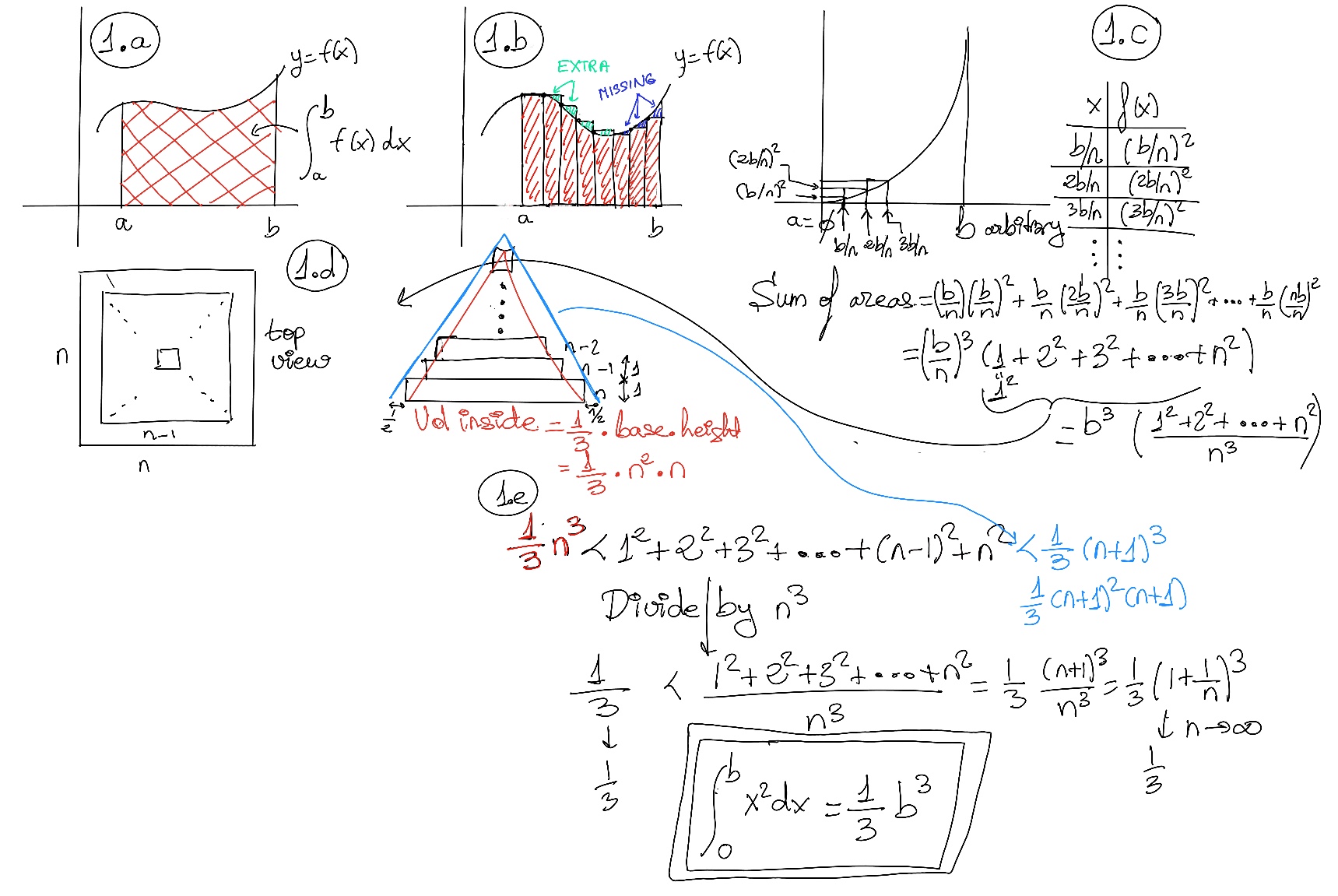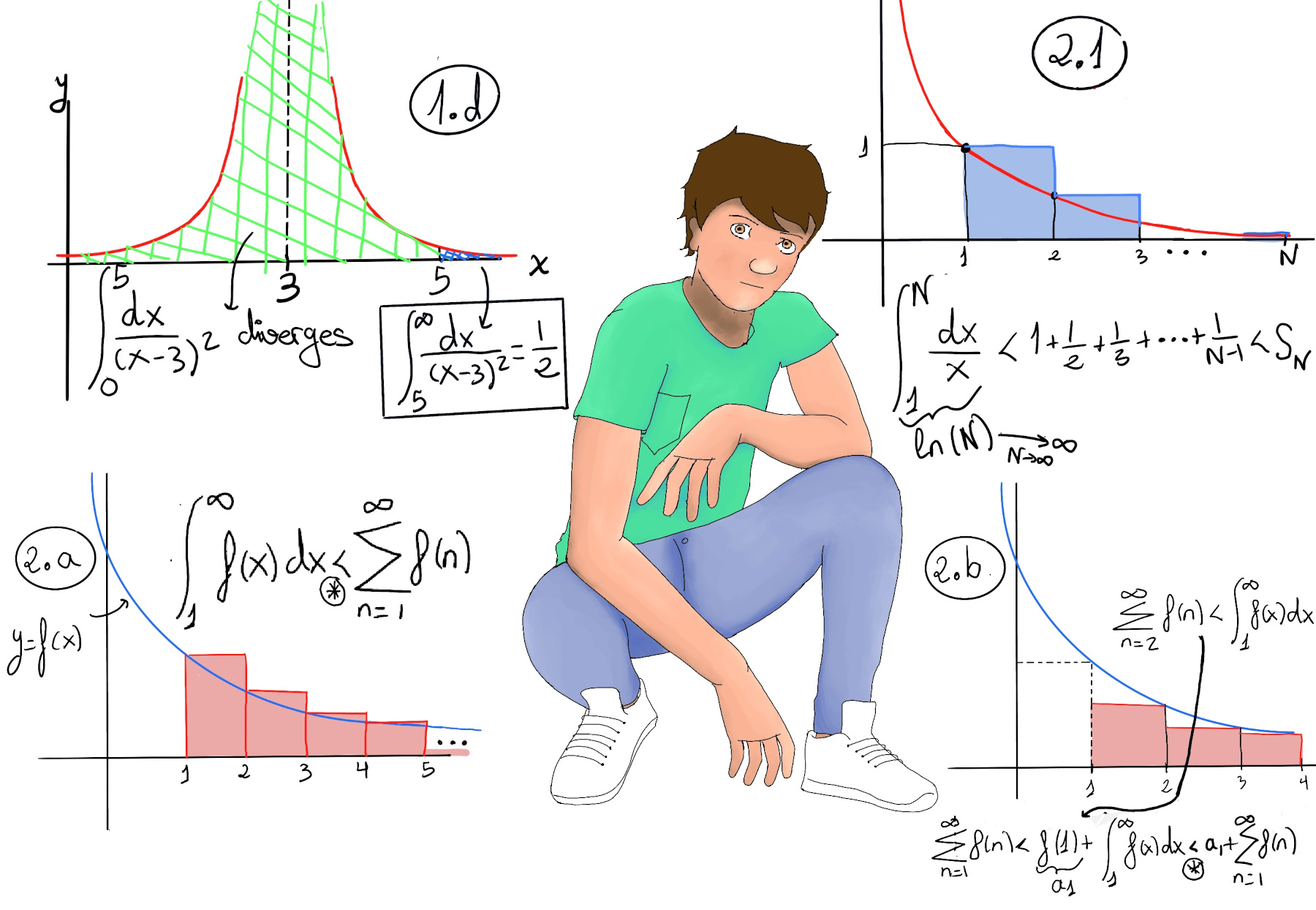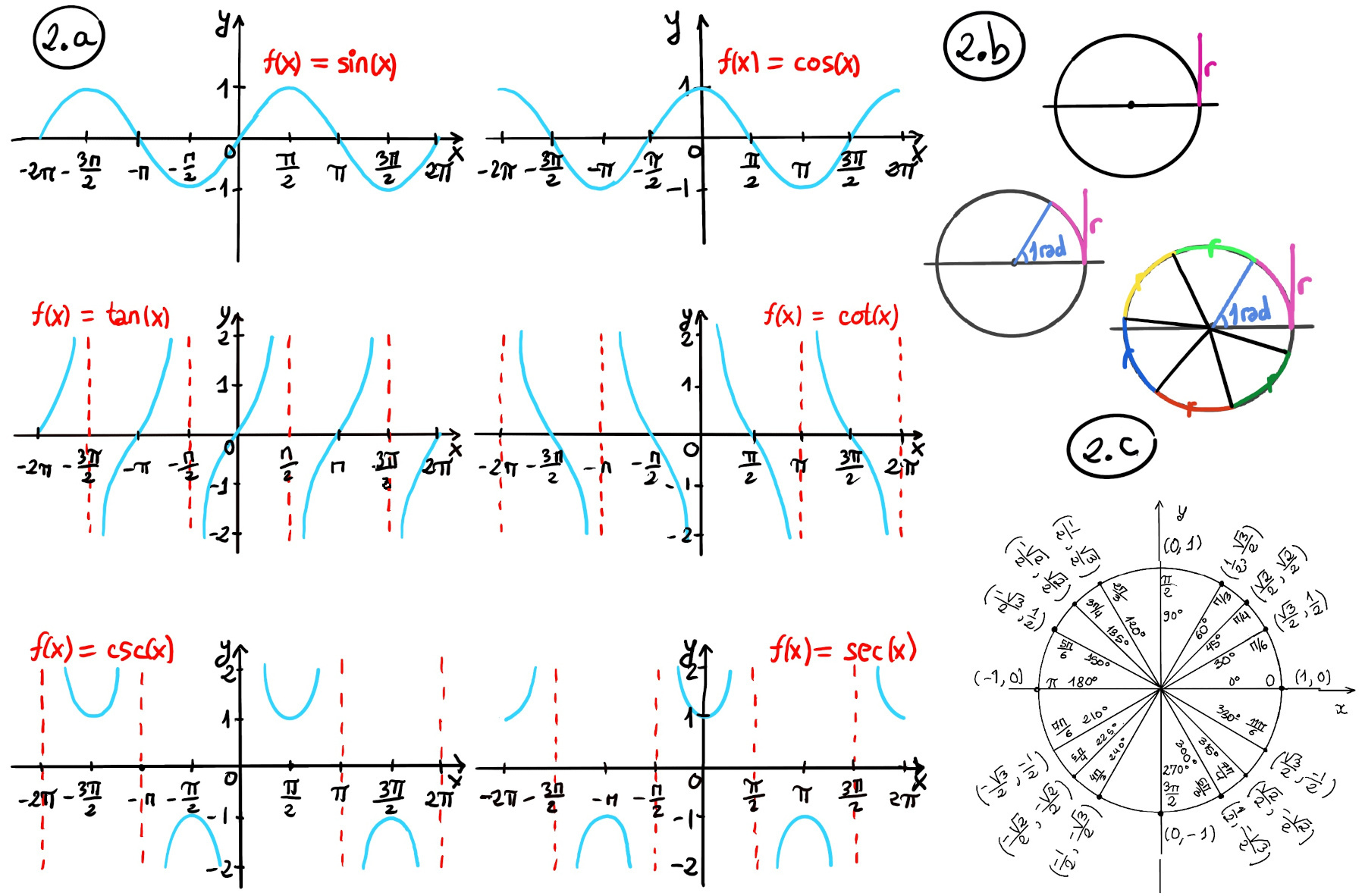
|
 |
 |

|
 |
 |
Winning isn’t everything, it’s the only thing, Vince Lombardi.
A definite integral is a mathematical concept used to find the area under a curve between two fixed limits. It is represented as $\int_{a}^{b}f(x)dx$, where a and b are the lower and upper limits, and f(x) is the integrand.
A definite integral of a function is defined as the area of the region bounded by the function's graph or curve between two points, say a and b, and the x-axis. The integral of a real-valued function f(x) on an interval [a, b] is written or expressed as $\int_{a}^{b} f(x)dx$ and it is illustrated in Figure 1.a.

The Fundamental Theorem of Calculus states roughly that the integral of a function f over an interval is equal to the change of any antiderivate F (F'(x) = f(x)) between the ends of the interval, i.e., $\int_{a}^{b} f(x)dx = F(b)-F(a)=F(x) \bigg|_{a}^{b}$
Definite integrals have specific limits of integration which determine the net area under the curve of the function between these limits. Improper integrals arise when the interval of integration is unbounded, that is, $\int_{a}^{∞} f(x)dx = \lim_{b \to ∞}\int_{a}^{b} f(x)dx$, or when the integrand is undefined at certain points within the interval of integration. Techniques for evaluating improper integrals involve taking limits as the integration bounds approach infinity or as singularities are approached.
One may be tempted to calculate $\int_{-1}^{1} \frac{dx}{x^2}=-x^{-1}\bigg|_{-1}^{1} = -2$, but this is wrong because 😞😞😞
$\int_{0}^{1} \frac{dx}{x^2}$ diverges.
An improper integral of the second kind arises when the integrand becomes unbounded or approaches infinity within the interval of integration. The integral $\int_{0}^{1} f(x)dx = \lim_{a \to 0^+} \int_{a}^{1} f(x)dx$ converges if the limit exists, and diverges if the limit does not exist (Figure 1.a.).

$\int_{0}^{1} x^{\frac{-1}{2}}dx = \lim_{a \to 0^+} \int_{a}^{1} x^{\frac{-1}{2}}dx = \lim_{a \to 0^+} 2x^{1/2}\bigg|_{a}^{1}$
$= \lim_{a \to 0^+} 2 -2\sqrt{a} = 2$, so the improper integral $\int_{0}^{1} \frac{dx}{\sqrt{x}}$ converges and is equal to 2 (Figure 1.b.).

$\int_{0}^{1} \frac{dx}{x} = \lim_{a \to 0^+} \int_{a}^{1} \frac{dx}{x} = \lim_{a \to 0^+} lnx\bigg|_{a}^{1}$
$ = \lim_{a \to 0^+} ln1 -lna = \lim_{a \to 0^+} -lna = -(-∞) = ∞$, so this improper integral diverges (Figure 1.c.).

The idea is quite simple, $\frac{1}{x^{1/2}} « \frac{1}{x}« \frac{1}{x^2}$ as x → 0+, the first integral is convergent (small enough), but the other two improper integral diverge. Similarly, $\frac{1}{x^{1/2}} » \frac{1}{x} » \frac{1}{x^2}$ as x → ∞, the only one that is convergent is the last one.
$= \lim_{a \to 1⁺} \frac{1}{3} ln(\frac{2-1}{2+2})- \frac{1}{3} ln(\frac{a-1}{a+2})= \frac{1}{3} \lim_{a \to 1⁺} ln(\frac{1}{4})- ln(\frac{a-1}{a+2}) = -(-∞) = ∞,$ so it diverges.
=$ \lim_{a \to 0⁺} e^{\frac{1}{a}}-e = ∞$, it diverges.
$ = \lim_{a \to 1⁺} 2\sqrt{1}-2\sqrt{ln(a)} = 2.$
$\int_{0}^{2} \frac{x}{x-2}dx = \lim_{b \to 2⁻} \int_{0}^{b} \frac{x}{x-2}dx = \lim_{b \to 2⁻} \int_{0}^{b} \frac{x-2+2}{x-2}dx = \lim_{b \to 2⁻} \int_{0}^{b} 1dx+ \int_{0}^{b} \frac{2}{x-2}dx = \lim_{b \to 2⁻} (x+2ln|x-2|)\bigg|_{0}^{b} =$
$\lim_{b \to 2⁻} (b+2ln|b-2|-(0+2ln|-2|)) = \lim_{b \to 2⁻} (b+2ln|b-2|-2ln(2))) = -∞,$ it diverges.
$\int_{5}^{∞} \frac{dx}{(x-3)^2} = \lim_{b \to ∞} \int_{5}^{b} \frac{dx}{(x-3)^2} = \lim_{b \to ∞} \frac{-1}{x-3}\bigg|_{5}^{b} = $
$\lim_{b \to ∞} (\frac{-1}{b-3}+\frac{1}{5-3}) = \frac{1}{2}$. Hence, $\int_{5}^{∞} \frac{dx}{(x-3)^2}$ converges, and its value is 1/2. However,
$\int_{0}^{3} \frac{dx}{(x-3)^2} = \lim_{c \to 3^-} \int_{0}^{c} \frac{dx}{(x-3)^2} = \lim_{c \to 3^-} \frac{-1}{x-3}\bigg|_{0}^{c} = $
$\lim_{c \to 3^-} (\frac{-1}{c-3}+\frac{1}{0-3}) = ∞$. So, the improper integral $\int_{0}^{3} \frac{dx}{(x-3)^2}$ diverges to infinite.
Similarly, $\int_{3}^{5} \frac{dx}{(x-3)^2} = \lim_{a \to 3^+} \int_{a}^{5} \frac{dx}{(x-3)^2} = \lim_{a \to 3^+} \frac{-1}{x-3}\bigg|_{a}^{5} = $
$\lim_{a \to 3^+} (\frac{-1}{5-3}+\frac{1}{a-3}) = ∞$. So, the improper integral $\int_{3}^{5} \frac{dx}{(x-3)^2}$ diverges to infinite ⇒ $\int_{0}^{∞} \frac{dx}{(x-3)^2}$ diverges (Figure 1.d).

=$\lim_{a \to 0⁺} \frac{ln(1)·1}{2}-\frac{1}{4}-(\frac{ln(a)a^2}{2}-\frac{a^2}{4}) = \lim_{a \to 0⁺} -\frac{1}{4}-\frac{ln(a)a^2}{2}-\frac{a^2}{4} = -\frac{1}{4}.$
$\lim_{a \to 0⁺} \frac{ln(a)a^2}{2} = \lim_{a \to 0⁺} \frac{ln(a)}{\frac{2}{a^2}} = \lim_{a \to 0⁺} \frac{\frac{1}{a}}{\frac{-4}{a^3}} = \lim_{a \to 0⁺} \frac{-a^2}{4}=0$
$=\lim_{b \to ∞} ln|b|-ln|b+1|-(ln|1|-ln|2|) = \lim_{b \to ∞} ln(\frac{b}{b+1}) +ln(2)= 0+ln(2) = ln(2),$ the integral converges.
$\int \frac{1}{x\sqrt{x^2-4}}dx = \frac{1}{2} \int \frac{1}{u\sqrt{u^2-1}} du$ [Recall, $sec^{-1}(x)=\frac{1}{x\sqrt{x^2-1}}$] = $\frac{1}{2} sec^{-1}(\frac{x}{2})+C.$
$\int_{2}^{∞} \frac{1}{x\sqrt{x^2-4}}dx = \int_{2}^{3} \frac{1}{x\sqrt{x^2-4}}dx + \int_{3}^{∞} \frac{1}{x\sqrt{x^2-4}}dx$
$\int_{2}^{3} \frac{1}{x\sqrt{x^2-4}}dx = \lim_{a \to 2⁺} \int_{a}^{3} \frac{1}{x\sqrt{x^2-4}}dx = \lim_{a \to 2⁺} \frac{1}{2} sec^{-1}(\frac{x}{2})\bigg|_{a}^{3}$ =
$\lim_{a \to 2⁺} \frac{1}{2} sec^{-1}(\frac{3}{2})-\frac{1}{2} sec^{-1}(\frac{a}{2}) = \frac{1}{2} sec^{-1}(\frac{3}{2})-\frac{1}{2} sec^{-1}(1) = \frac{1}{2} sec^{-1}(\frac{3}{2}).$
$\int_{3}^{∞} \frac{1}{x\sqrt{x^2-4}}dx = \lim_{b \to ∞} \int_{3}^{b} \frac{1}{x\sqrt{x^2-4}}dx = \lim_{b \to ∞} (\frac{1}{2}sec^{-1}(\frac{b}{2})-\frac{1}{2}sec^{-1}(\frac{3}{2}))$ =[Figure 2.a, sec(x)→ ∞ when x → π⁄2 ↭ sec-1(b⁄2)→π⁄2 when b⁄2→ ∞] $\frac{1}{2}·\frac{π}{2}-\frac{1}{2}sec^{-1}(\frac{3}{2}) = \frac{π}{4}-\frac{1}{2}sec^{-1}(\frac{3}{2})$, hence, $\int_{2}^{∞} \frac{1}{x\sqrt{x^2-4}}dx = \frac{1}{2} sec^{-1}(\frac{3}{2})+\frac{π}{4}-\frac{1}{2}sec^{-1}(\frac{3}{2}) $
